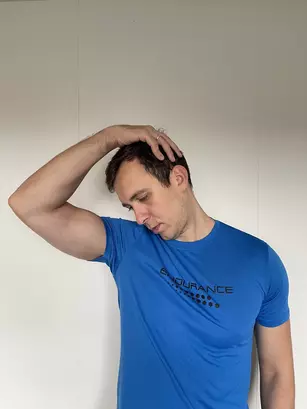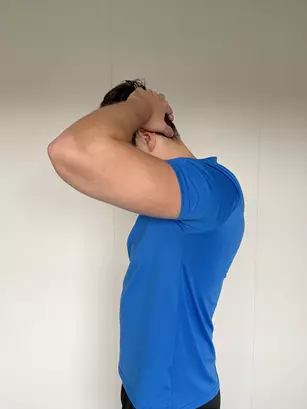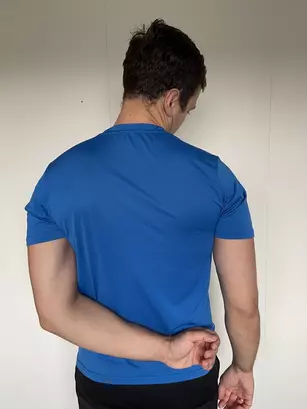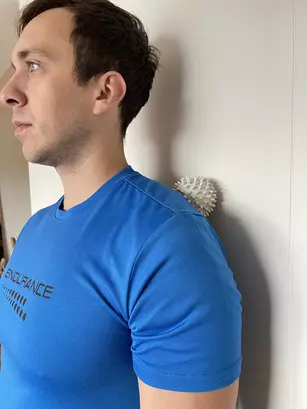Best Trapezius Stretches: Loosen Your Traps Effectively
Best Trapezius Stretches for Neck and Upper Back
The trapezius muscle plays an important role in our daily activities, from turning our heads to lifting objects.
Regular stretching can help maintain its flexibility, prevent pain, and enhance overall neck and upper back health.
Here are some effective stretches to loosen your trapezius muscles and alleviate discomfort:
4 Best Stretches for Traps
Lateral Flexion of Head and Neck
- Start from a standing position with your spine straight and shoulders relaxed.
- Place your right hand on the top of your head, just above your left ear.
- Gently pull your head to the right side, bringing your ear closer to your shoulder. Ensure you keep your shoulders down and avoid lifting the opposite shoulder.
- Hold this stretch for 30s.
Neck Flexion and Rotation
- Start from a standing position with your spine straight and shoulders relaxed.
- Place your right hand on the back left side of your head, just above the base of your skull.
- Gently turn your head to the right, looking over your shoulder.
- As you maintain the rotation, gently push your head downward using your hand. You should feel a stretch on the back left side of your neck.
- Hold this position for 30s.
Neck Flexion with Both Hands
- Begin in a seated or standing position, ensuring your spine is straight and your shoulders are relaxed.
- Interlock your fingers and place both hands at the back of your head, with your palms cradling the base of your skull.
- Gently press your head downward, aiming to bring your chin towards your chest.
- Hold this stretch for 30s.
Neck Rotation With Hand Behind Back
- Start from a standing position with shoulder relaxed.
- Place one hand behind back, reaching to the opposite hip.
- Then, rotate gently your head to the opposite side and bend your neck afterwards.
- Hold this stretch for 30s.
How to Release the Trapezius with a Massage Ball
Releasing tension in the trapezius muscle can be a game-changer for those experiencing neck and upper back discomfort. Using a massage ball is one of the best trapezius stretches techniques to target and alleviate tightness.
- Find a Stable Surface
- Begin by finding a stable wall. The wall will provide the resistance needed to press the massage ball into the trapezius muscle.
- Position the Massage Ball
- Place the massage ball between your upper trapezius (the muscle between your neck and shoulder) and the wall.
- Adjust the ball to the spot where you feel the most tension. This is typically where trapezius trigger points are located.
- Apply Pressure and Roll
- Lean into the ball, applying a moderate amount of pressure. Ensure it’s comfortable and not causing pain.
- Slowly roll the ball in circular motions, targeting the tight areas of the trapezius muscle.
- This technique is one of the best trapezius massage therapy to release knots and tightness.
- Focus on Tight Spots
- When you find a particularly tight or tender spot (often referred to as a “knot”), pause and apply steady pressure with the massage ball.
- Breathe deeply and allow the muscle to release. This is essential when performing stretches for traps using a massage ball.
- Switch Sides
- After spending 2-3 minutes on one side, switch to the other side and repeat the process.
Signs of a Tight Trapezius Muscle
Do you often feel a nagging pain in your neck or shoulders? It might be due to a tight trapezius muscle. Here’s how you can spot it:
- Neck Discomfort: If turning your head feels stiff or painful, your trapezius might be tight.
- Shoulder Aches: A sore feeling in the shoulders, especially when you lift things or stretch, is another sign.
- Headaches: Ever get a headache that starts at the back of your head and moves to the front? That’s often from a tight trapezius.
- Tender Spots or Knots: Gently press along your neck and shoulder. If you find spots that feel sore or like tiny bumps, those might be trapezius trigger points – tight spots in the muscle.
- Feeling Limited: If moving your neck or shoulders feels restricted, like you can’t move them as much as usual, it’s another hint.
If any of these sound familiar, some good stretches might help. Remember, regular trapezius stretches can make a big difference in how you feel!
Common Causes of Tight Trapezius Muscles
Traps are very sensitive and tightness in traps can be caused by several reasons. Let me explain here.
- Poor Posture: Spending hours hunched over a computer or looking down at your phone? Bad posture is a top culprit for tight traps. It’s essential to maintain a good stance to prevent trapezius muscle pain.
- Heavy Lifting: Lifting heavy objects without proper technique can strain the trapezius. Always ensure you’re lifting with your legs and not just your back and shoulders.
- Stress: Believe it or not, emotional stress can lead to physical tension. When we’re stressed, we often tense our shoulders, leading to trapezius trigger points or knots.
- Injuries: Past injuries, like whiplash or sprains, can cause lingering tightness in the trapezius muscle.
- Lack of Exercise: Not moving enough? A sedentary lifestyle can make muscles stiff, including the trapezius. Incorporating regular trapezius stretches can help keep things loose.
- Repetitive Movements: Doing the same motion over and over, like painting a ceiling or playing certain sports, can overwork the trapezius.
Benefits of Trapezius Stretching
Incorporating trapezius stretches into your routine, whether you’re an athlete, office worker, or anyone in between, can significantly benefit your physical well-being and overall quality of life.
- Pain Relief
- Improved Posture
- Increased Range of Motion
- Stress Reduction
- Prevention of Injuries
- Enhanced Blood Circulation
- Optimal Muscle Function
- Better Athletic Performance
- Reduced Muscle Imbalances
- Therapeutic Benefits
Tips When Stretching the Trapezius Muscle
- Warm Up First: Before diving into stretches, ensure you’ve warmed up with some light aerobic activity, like walking or jogging, to increase blood flow to the muscles.
- Maintain Good Form: Proper technique is crucial. Ensure your spine is aligned and you’re not compensating with other parts of your body.
- Hold, Don’t Bounce: When stretching, hold the position steadily. Avoid bouncing, as this can lead to muscle strain.
- Breathe Deeply: Deep, controlled breathing helps relax the muscle and enhances the stretch’s effectiveness.
- Listen to Your Body: Stretching should feel like a gentle pull, not painful. If you experience pain, ease back a bit.
- Stay Consistent: For best results, incorporate trapezius stretches into your routine regularly.
- Use Props: Tools like foam rollers or massage balls can enhance the stretch and target tight spots more effectively.
- Stay Hydrated: Drinking water helps keep muscles pliable and reduces the risk of cramps.
- Hold Stretches Long Enough: Aim to hold each stretch for 30 seconds to allow the muscle to relax fully.
- Consult a Professional: If you’re unsure about your technique or have existing injuries, consider seeking advice from a physical therapist or fitness expert.
Frequently Asked Questions
-
How can I effectively loosen my trapezius muscles?
- Regular stretching, massage therapy, and maintaining good posture can help in effectively loosening the trapezius muscles. It’s also essential to take breaks if you’re sitting for extended periods.
-
What can I do for trapezius muscle pain relief?
- Applying heat, using over-the-counter pain relievers, and performing targeted trapezius stretches can provide relief. If the pain persists, it’s advisable to consult a healthcare professional.
-
How do trapezius stretches improve posture?
- Stretching the trapezius muscle can help alleviate tightness and imbalances, leading to a more upright and aligned posture in your upper back.
-
Are there specific upper trapezius stretch techniques?
- Yes, techniques like the neck tilt stretch and lateral neck flexion stretch specifically target the upper trapezius region.
-
What is the postisometric relaxation technique for trapezius?
- It’s a method where the trapezius muscle is first contracted and then relaxed, followed by a stretch. This technique can help in increasing the muscle’s length and flexibility.
-
Why do I need trapezius stretches for neck and shoulder pain?
- The trapezius muscle plays a significant role in neck and shoulder movements. Tightness in this muscle can lead to pain in these areas, making stretching essential for relief.
-
Can you explain the trapezius muscle anatomy and function?
- The trapezius is a large, triangular muscle that spans the neck, shoulders, and upper back. It assists in moving and stabilizing the shoulder blades and supports the arm’s weight.
-
Are there exercises for calcific tendonitis in the trapezius?
- Yes, gentle stretching and strengthening exercises, under the guidance of a physical therapist, can help manage and alleviate symptoms of calcific tendonitis in the trapezius.
-
How can I address trapezius muscle middle back pain solutions?
- Regular trapezius stretches, maintaining proper posture, and strengthening exercises can help address middle back pain associated with the trapezius muscle.
-
What are the methods for treating trapezius muscle injuries?
- Physical therapy, massage, and targeted exercises can also aid in the recovery and treatment of trapezius muscle injuries.
Referances
- Effect of a Long Exercise Program in the Reduction of Musculoskeletal Discomfort in Office Workers
- The effect of middle and lower trapezius strength exercises and levator scapulae and upper trapezius stretching exercises in upper crossed syndrome
- How to do the Upper Trapezius Stretch: Techniques, Benefits, Variations





